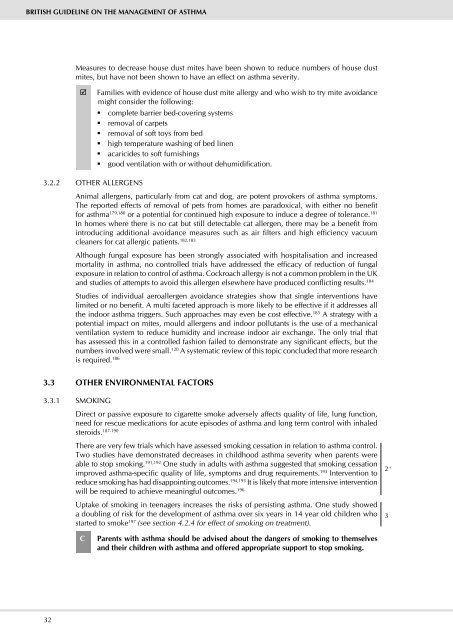sign101
sign101
sign101
Create successful ePaper yourself
Turn your PDF publications into a flip-book with our unique Google optimized e-Paper software.
British Guideline on the MAnAGeMent of AsthMA<br />
32<br />
Measures to decrease house dust mites have been shown to reduce numbers of house dust<br />
mites, but have not been shown to have an effect on asthma severity.<br />
; Families with evidence of house dust mite allergy and who wish to try mite avoidance<br />
might consider the following:<br />
complete barrier bed-covering systems<br />
removal of carpets<br />
removal of soft toys from bed<br />
high temperature washing of bed linen<br />
acaricides to soft furnishings<br />
good ventilation with or without dehumidification.<br />
3.2.2 OTHER ALLERGENS<br />
Animal allergens, particularly from cat and dog, are potent provokers of asthma symptoms.<br />
The reported effects of removal of pets from homes are paradoxical, with either no benefit<br />
for asthma 179,180 or a potential for continued high exposure to induce a degree of tolerance. 181<br />
In homes where there is no cat but still detectable cat allergen, there may be a benefit from<br />
introducing additional avoidance measures such as air filters and high efficiency vacuum<br />
cleaners for cat allergic patients. 182,183<br />
Although fungal exposure has been strongly associated with hospitalisation and increased<br />
mortality in asthma, no controlled trials have addressed the efficacy of reduction of fungal<br />
exposure in relation to control of asthma. Cockroach allergy is not a common problem in the UK<br />
and studies of attempts to avoid this allergen elsewhere have produced conflicting results. 184<br />
Studies of individual aeroallergen avoidance strategies show that single interventions have<br />
limited or no benefit. A multi faceted approach is more likely to be effective if it addresses all<br />
the indoor asthma triggers. Such approaches may even be cost effective. 185 A strategy with a<br />
potential impact on mites, mould allergens and indoor pollutants is the use of a mechanical<br />
ventilation system to reduce humidity and increase indoor air exchange. The only trial that<br />
has assessed this in a controlled fashion failed to demonstrate any significant effects, but the<br />
numbers involved were small. 120 A systematic review of this topic concluded that more research<br />
is required. 186<br />
3.3 other environMentAl fACtors<br />
3.3.1 SMOKING<br />
Direct or passive exposure to cigarette smoke adversely affects quality of life, lung function,<br />
need for rescue medications for acute episodes of asthma and long term control with inhaled<br />
steroids. 187-190<br />
There are very few trials which have assessed smoking cessation in relation to asthma control.<br />
Two studies have demonstrated decreases in childhood asthma severity when parents were<br />
able to stop smoking. 191,192 One study in adults with asthma suggested that smoking cessation<br />
improved asthma-specific quality of life, symptoms and drug requirements. 193 Intervention to<br />
reduce smoking has had disappointing outcomes. 194,195 It is likely that more intensive intervention<br />
will be required to achieve meaningful outcomes. 196<br />
Uptake of smoking in teenagers increases the risks of persisting asthma. One study showed<br />
a doubling of risk for the development of asthma over six years in 14 year old children who<br />
started to smoke 197 (see section 4.2.4 for effect of smoking on treatment).<br />
C Parents with asthma should be advised about the dangers of smoking to themselves<br />
and their children with asthma and offered appropriate support to stop smoking.<br />
2 +<br />
3


